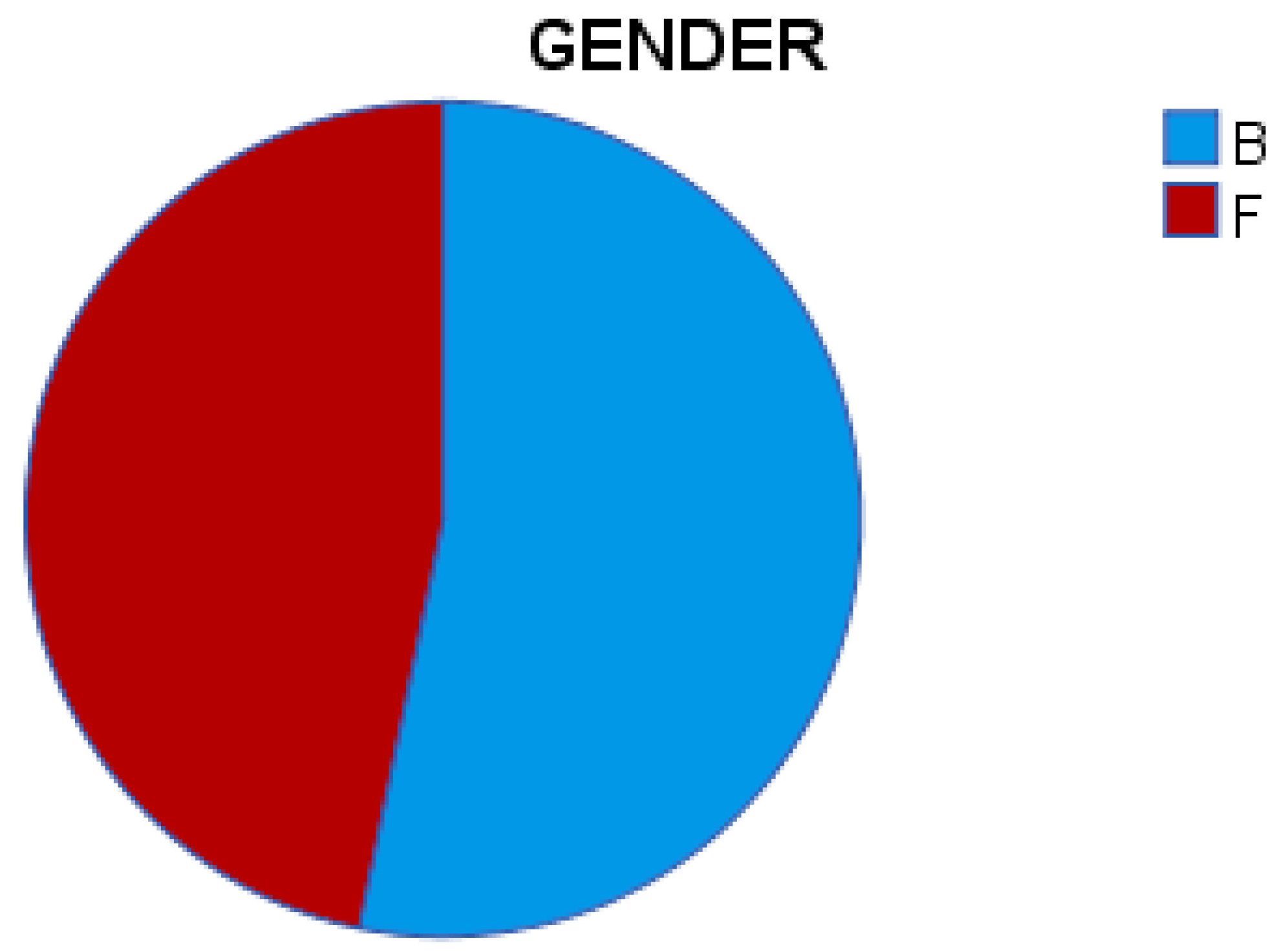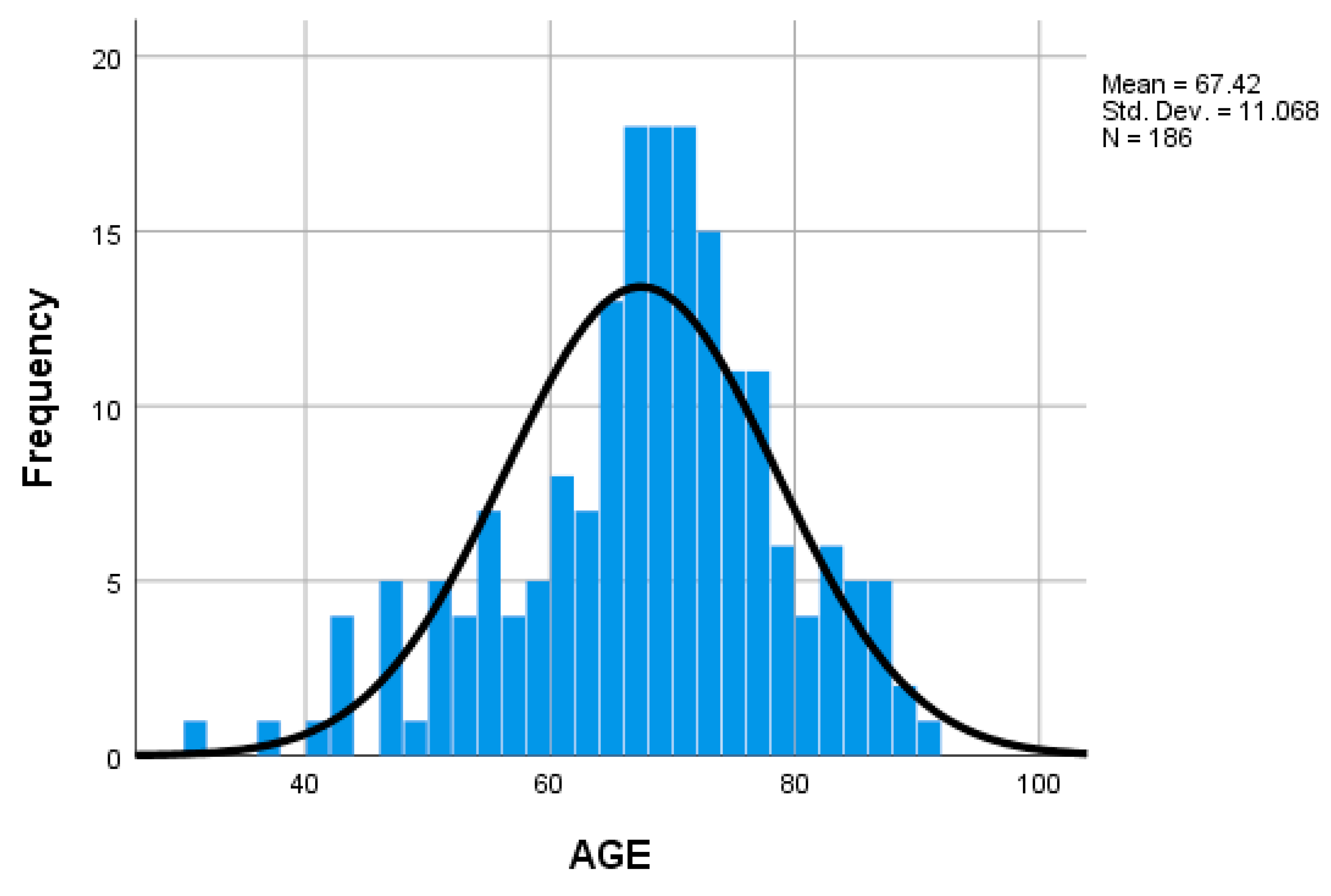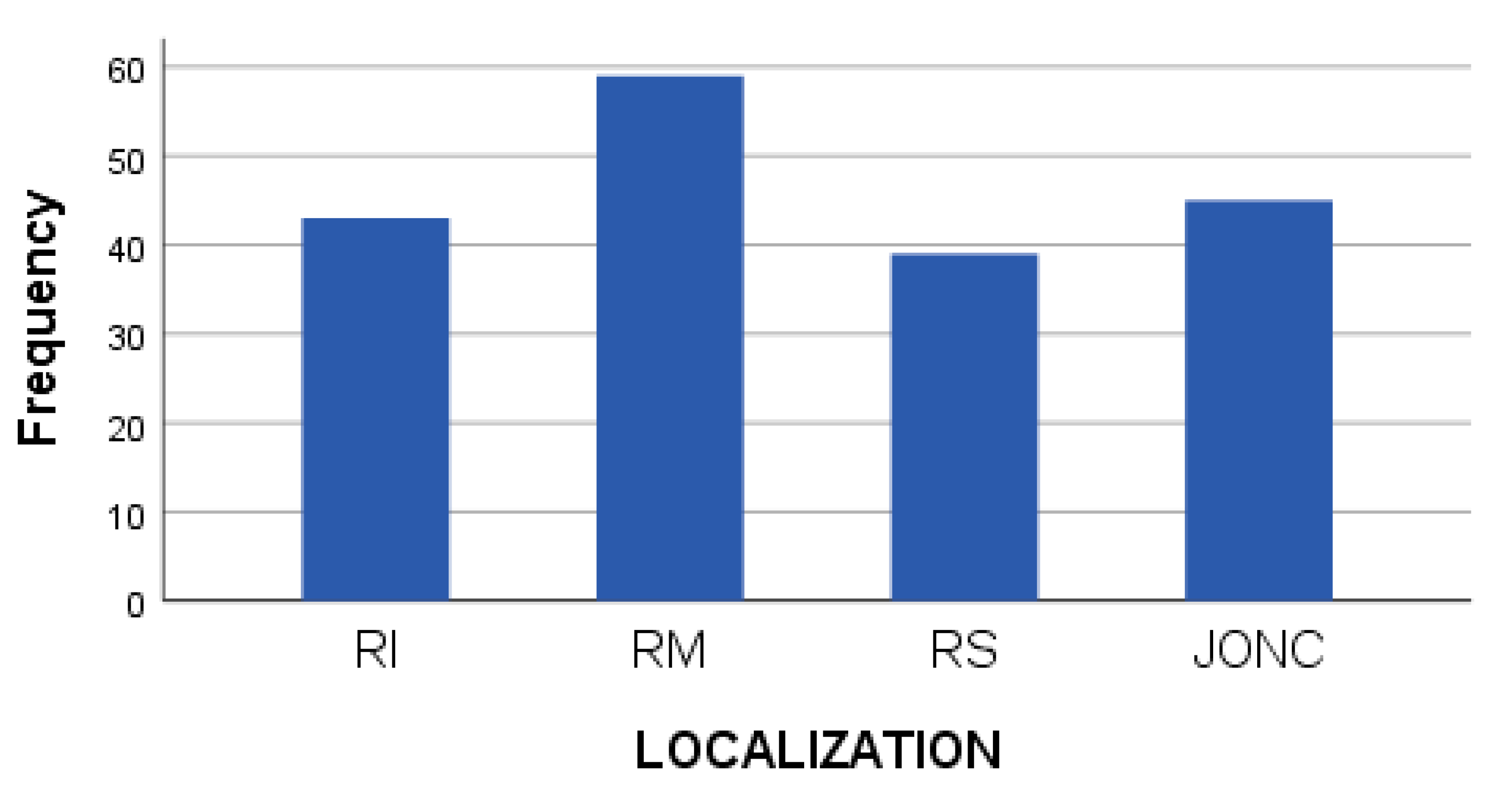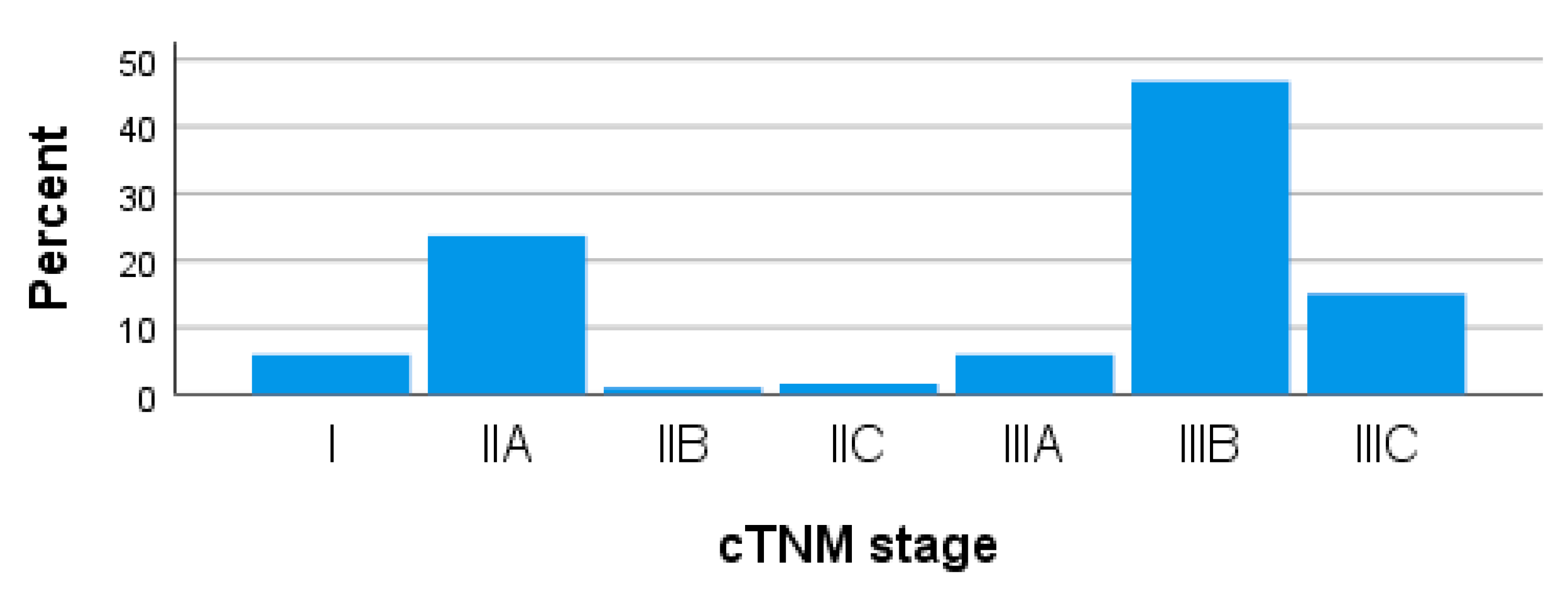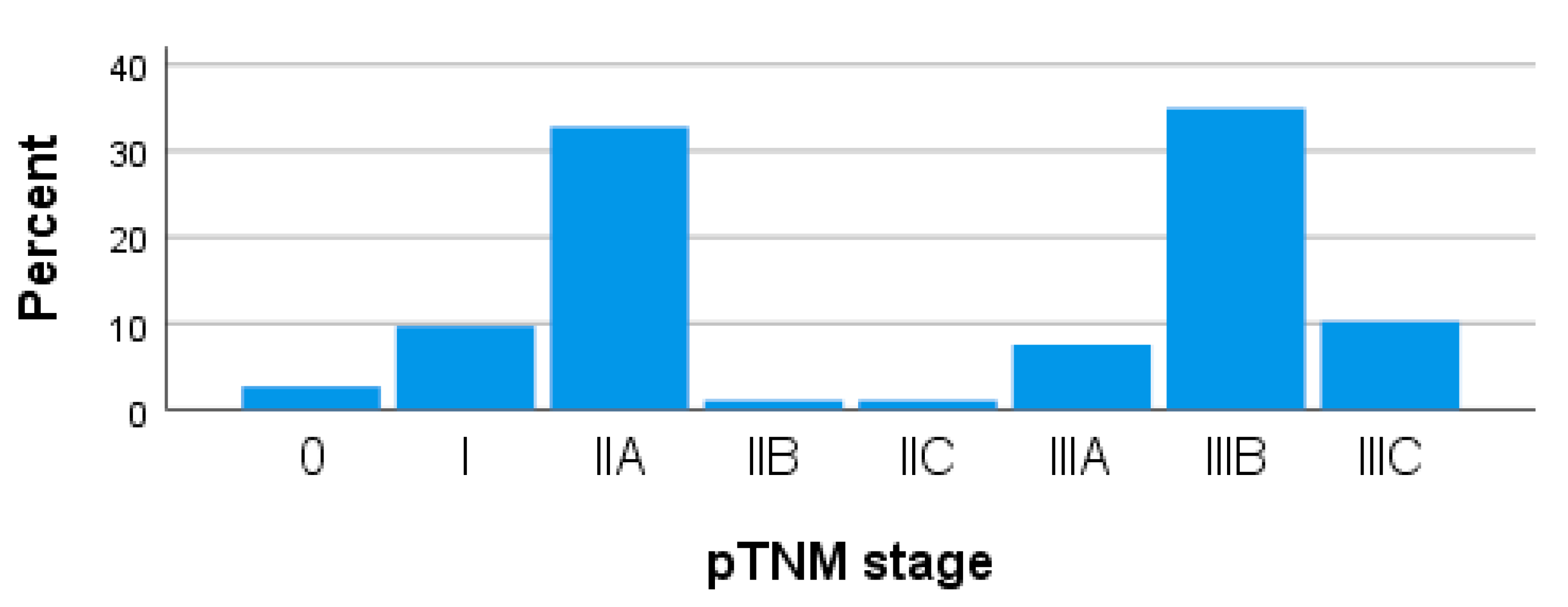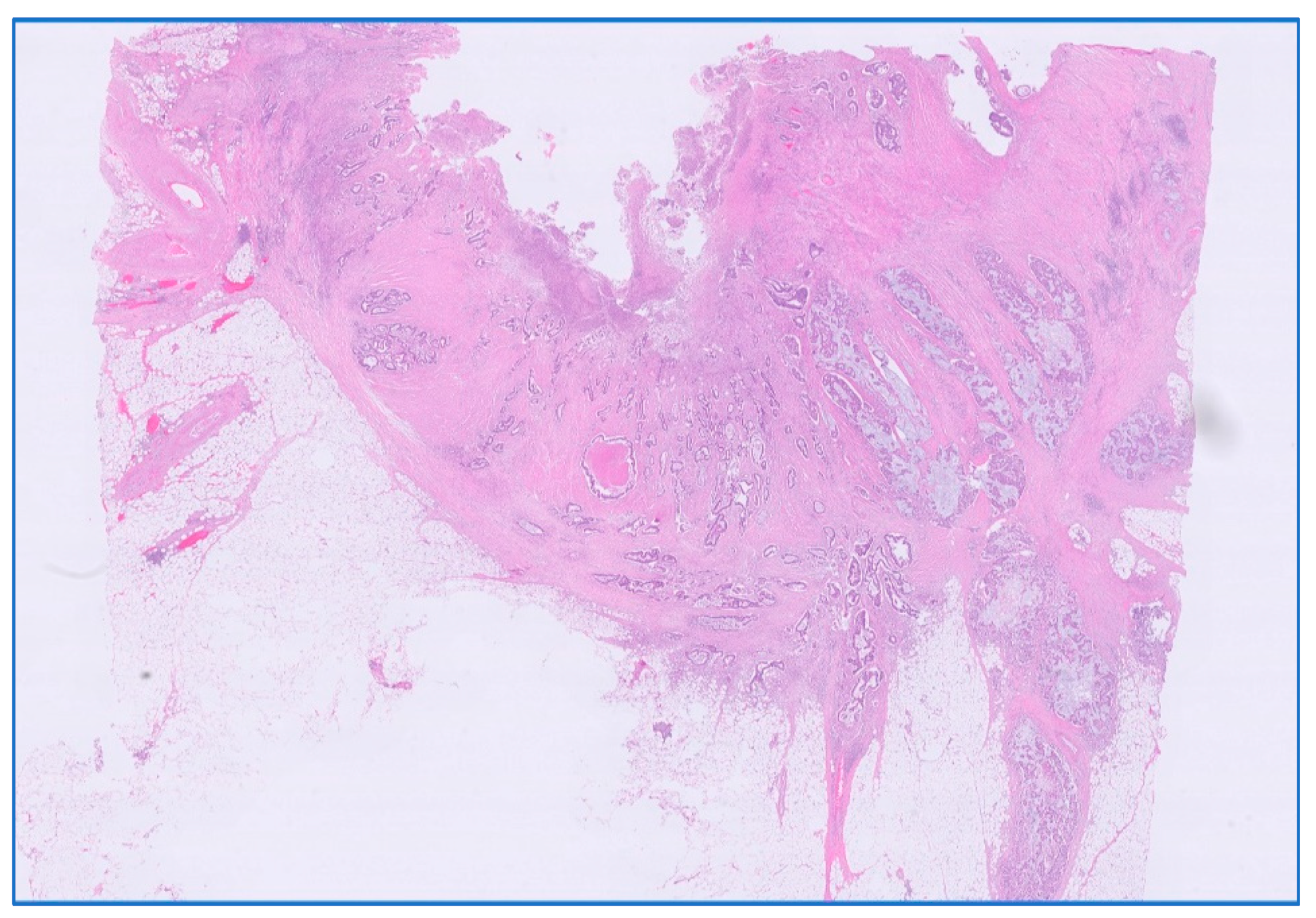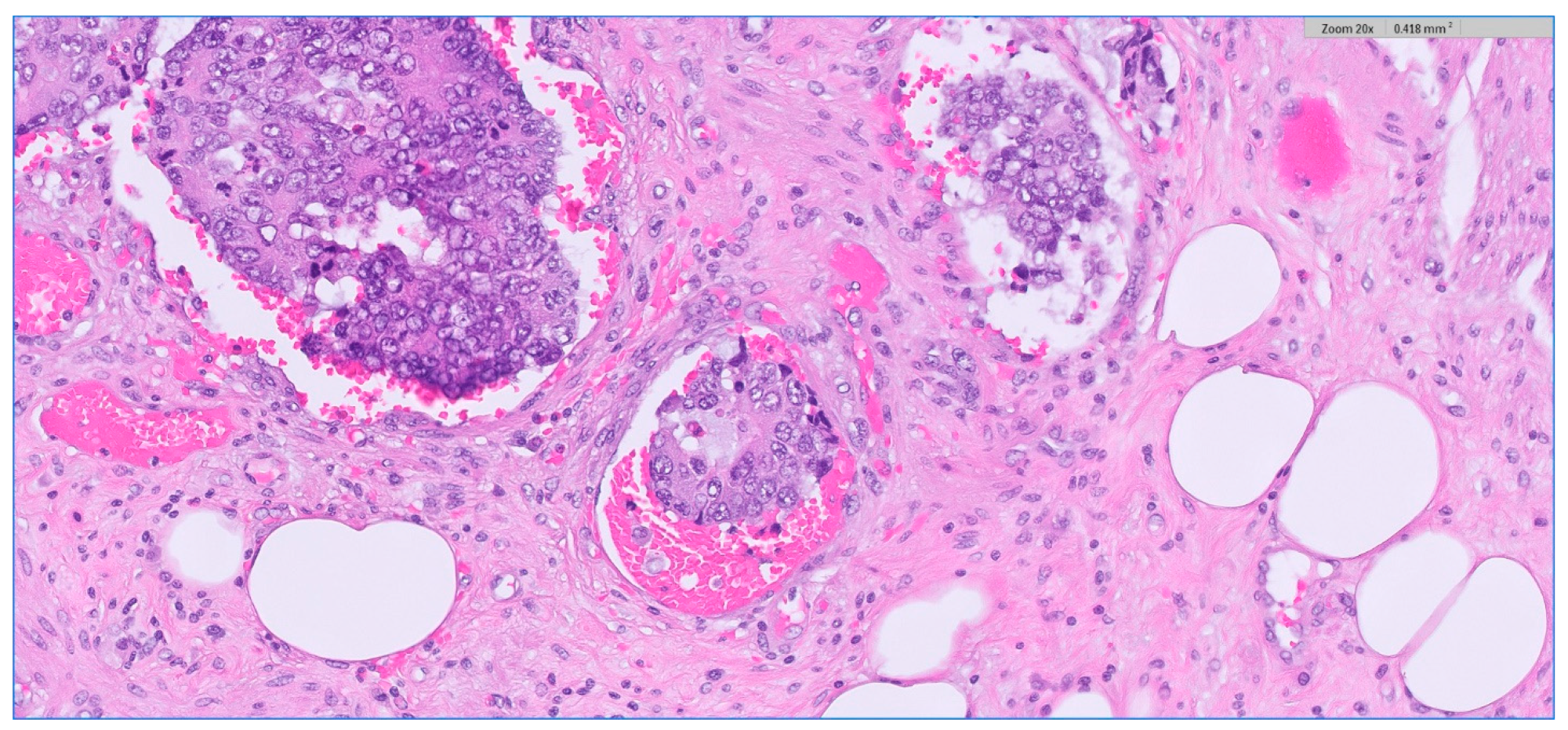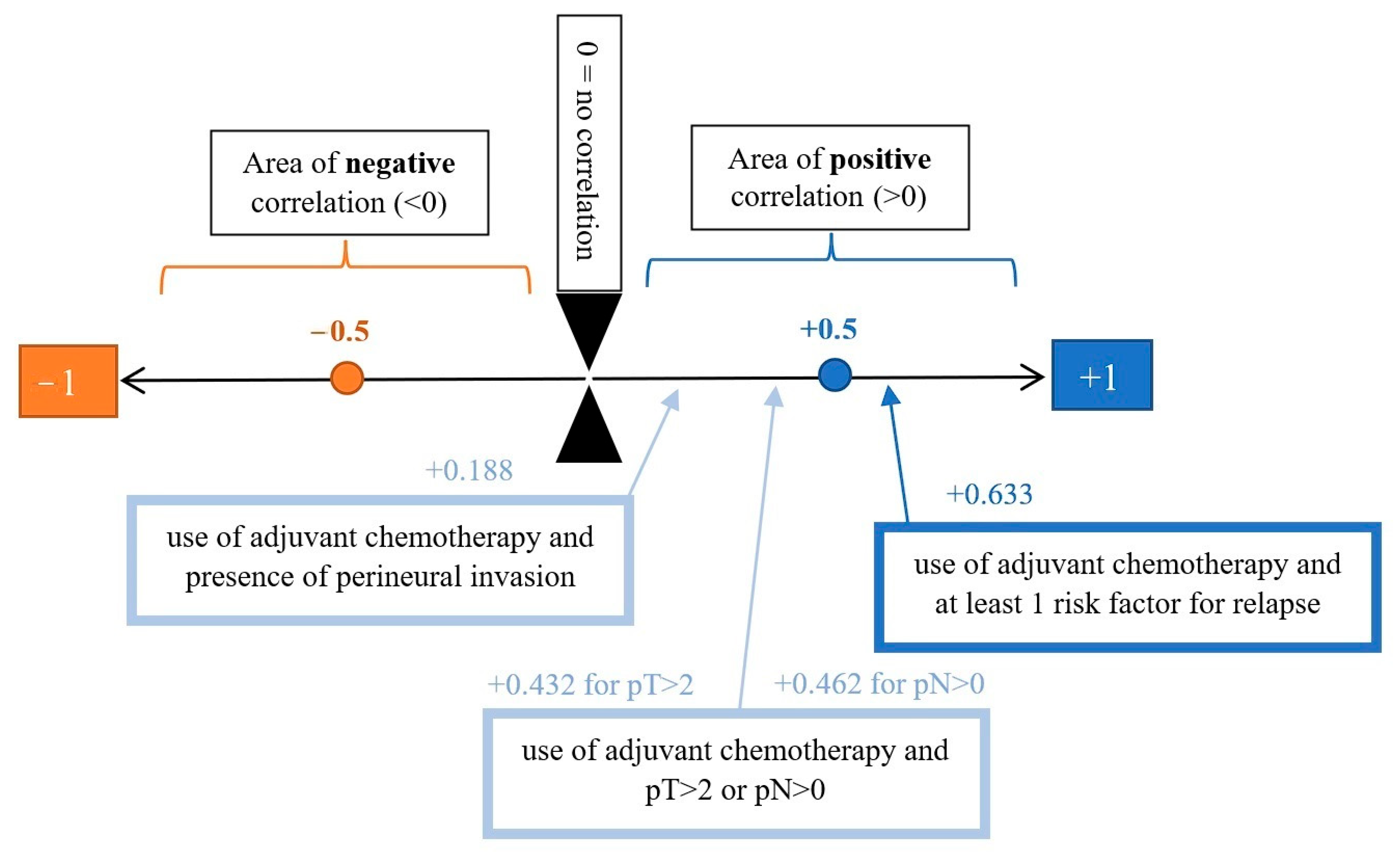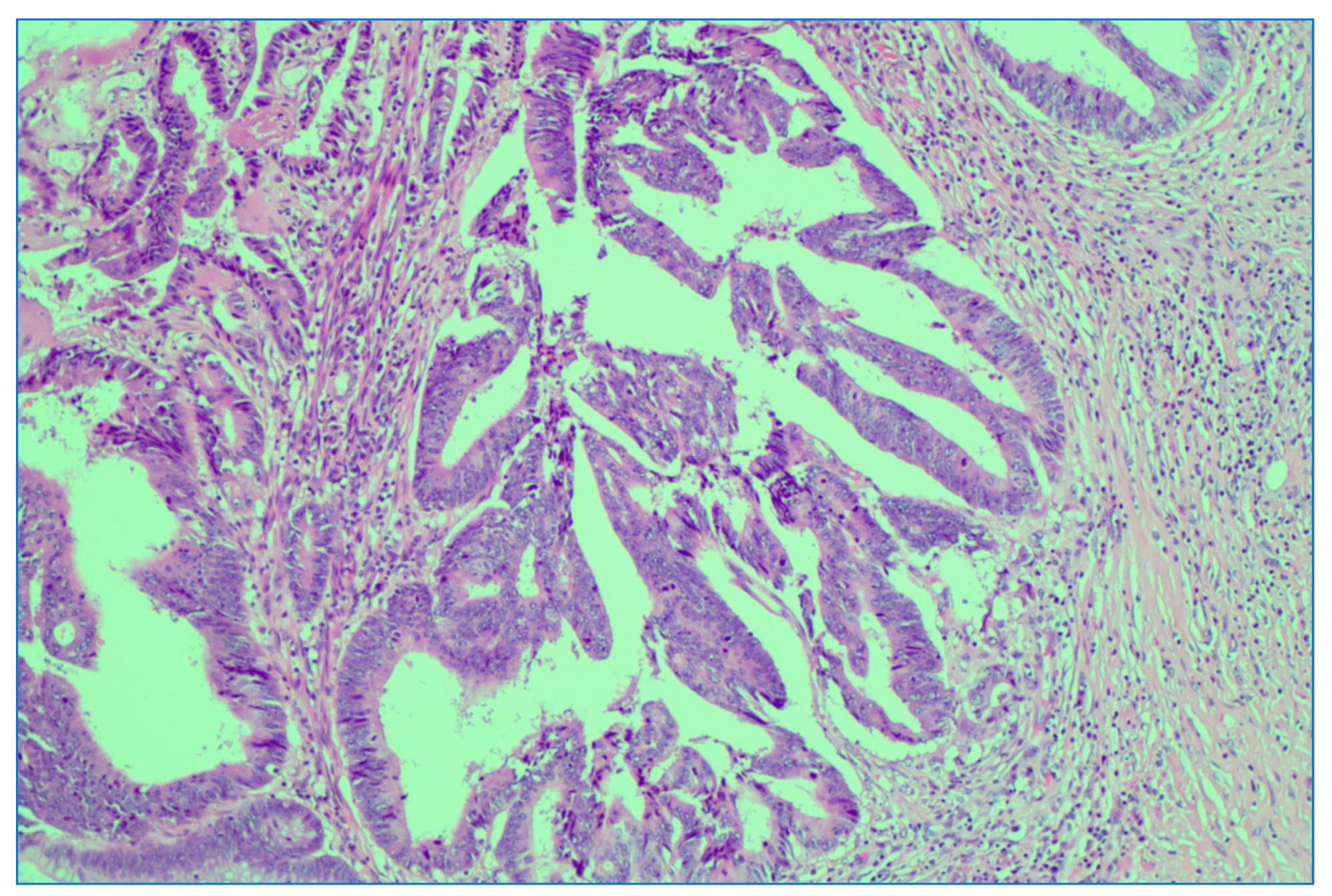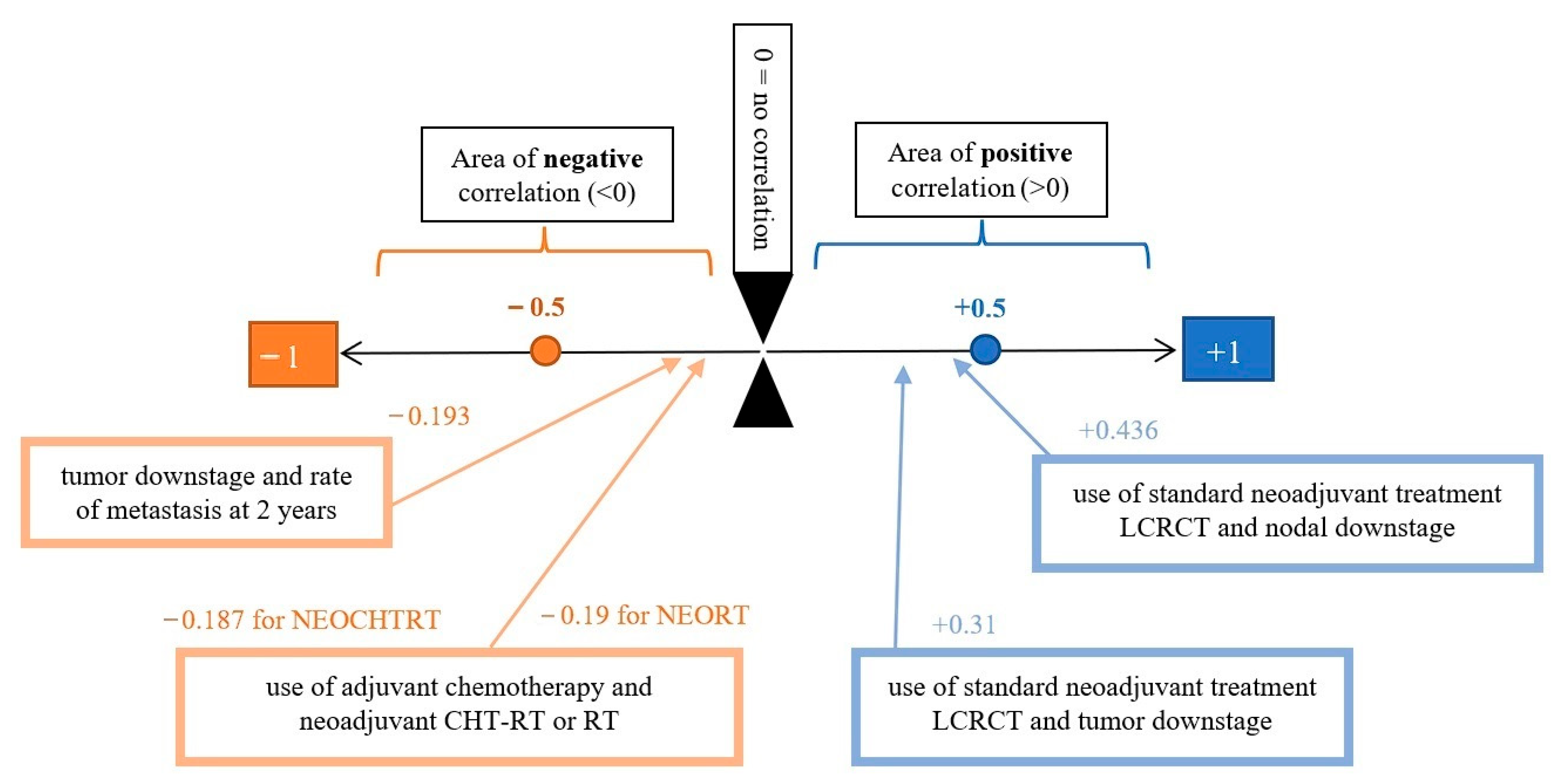2. Materials and Methods
2.1. Patients and Design
We conducted a retrospective study on 186 patients with clinically or pathologically diagnosed locally advanced rectal cancer in stages II or III who presented to the Radiotherapy or Medical Oncology Department of Colțea Clinical Hospital, Bucharest between January 2017 and March 2021. All patients included in the study underwent surgery using the TME technique via the low anterior or abdominoperineal approach and had an ECOG performance status of 0 or 1 at the time of surgery.
Epidemiological information was collected on gender, age, and tumor location described by the surgeon during colonoscopy at the lower rectal, middle rectal, upper rectal, or rectosigmoid junction. All patients were clinically and pathologically staged, and the following histopathological report data were analyzed: tumor and nodal stage (pT and pN), resection margins (Postop), histopathological grade (Grade), and the presence/absence of lymphovascular (LVI) and perineural invasion (PNI). The extent of extramural invasion was not analyzed as not all preoperative MRIs provided this information. The tumor marker CEA was not routinely recorded in all patients and was excluded from the statistical analysis.
2.2. Treatment
Patients with locally advanced rectal cancer who received neoadjuvant treatment underwent long-course external pelvic radiotherapy with doses between 45 and 50.4 Gy, using the 3D or IMRT techniques +/− chemotherapy with capecitabine at a dose of 825 mg/m2 twice daily during radiotherapy. TME surgery was performed for all patients 8–12 weeks after neoadjuvant treatment.
In the case of upper rectal cancer with sigmoid extension, some patients were treated with surgery per primam, followed by adjuvant treatment according to the postoperative pathological report.
Patients who received adjuvant chemotherapy received between 6 and 8 cycles (of 3 weeks each) of 1000 mg/m2 capecitabine twice daily on days 1–14, concurrently with 130 mg/m2 oxaliplatin on day 1, or 1250 mg/m2 capecitabine monotherapy twice daily on days 1–14 if biological constants did not allow platinum administration.
2.3. Follow-Up
Patients were followed up by the attending medical oncologist or radiation oncologist every 3 months and CT or MRI imaging investigations were performed for locoregional evaluation, as per the clinic protocol. Follow-up data from the first 2 years were analyzed for all patients and any local recurrences or distant metastasis were recorded.
2.4. Statistical Analysis
Statistical analysis was performed using IBM SPSS Statistics v29 software, applying Pearson correlations and t-test statistical significance tests between the use of adjuvant chemotherapy and each of the histopathological criteria: (y)pT, (y)pN, LVI, PNI, Postop, and Grade. The same correlation algorithm was applied to identify the link between the use of neoadjuvant radiotherapy (NEORT) or radiochemotherapy (NEOCHTRT), the occurrence of local recurrence (relapse2y) or metastatic disease (metastasis2y) in the first 2 years, and the occurrence of tumor (T.downstage) and nodal (N.downstage) downstaging.
3. Results
Of the total 186 patients included in the study, 53.2% of patients (n = 99) were male (B) and 46.8% (n = 87) were female (F) (
Table 1;
Figure 1).
The mean age of the patients was 67.42 years with a standard deviation of 11.07 years. A majority distribution of patients was observed in the 60–80 years age range (
Figure 2).
The location of the tumor was at the lower rectal (RI) level in 29.25% of cases (n = 43), at the middle rectal (RM) level in 40.14% of cases (n = 59), at the upper rectal (RS) level in 26.53% of cases (n = 49), and at the rectosigmoid junction (JONC) in 30.61% of cases (n = 45). Most of the patients had tumors located in the middle rectum (
Table 2,
Figure 3).
Compared to other rectal cancer studies, our study included patients with rectal tumors located higher up at the rectosigmoid junction, as some of them received neoadjuvant long-course radiochemotherapy treatment similar to standard rectal cancer treatment.
Pretreatment clinical staging includes 6.01% stage I patients (n = 11), 25.14% stage II patients (n = 46) and 68.85% stage III patients (n = 126) (
Figure 4).
When it comes to clinical substages, most stage II patients were found in substage IIA (rectal tumor penetrating the muscularis propria and invading the colorectal tissues, without clinically detectable adenopathy). Of the stage III patients, most could be clinically substaged in IIIB (rectal tumor invading or penetrating its own muscle, with the presence of up to six clinically detectable malign lymph nodes).
Pathological staging performed after surgery was composed of 2.69% stage 0 patients with pathological complete response after neoadjuvant treatment (n = 5), 9.68% stage I patients (n = 18), 34.95% stage II patients (n = 65), and 52.69% stage III patients (n = 98) (
Figure 5).
The substaging of patients in pathological stage II showed a clear majority of over 30% of patients in stage IIA. For stage III patients, most were pathologically substage IIIB, but with a significant 10% patients in stage IIIC.
We analyzed the correlation between adjuvant chemotherapy treatment and histopathology bulletin results by using the Pearson correlation coefficient and applying the two-tailed significance
t-test. The correlation between adjuvant chemotherapy and a pathological T staging greater than 2 (y)pT > 2 (
Figure 6) and between adjuvant chemotherapy and a positive pathological N staging (y)pN > 0 was tested. Other risk factors from the histopathology report that were taken into account were the presence of lymphovascular invasion LVI+ (
Figure 7), the presence of perineural invasion PNI+ (
Figure 8), positive resection margins Postop+, or a histopathological grade greater than 1 Grade > 1.
Adjuvant chemotherapy is positively correlated with a moderate score of 0.432 for a histopathological stage (y)pT3 or (y)pT4 (
Table 3). A moderate positive correlation score of 0.462 is also valid for the presence of nodal invasion (y)pN > 0. Both results are statistically significant with a score of
p < 0.001.
Analyzing the relationship between adjuvant chemotherapy, the presence of lymphovascular invasion, the presence of perineural invasion, the tumor grade, and the postoperative resection margins, the results show a very weak positive correlation between them, with a statistically significant
p only in the case of the correlation between adjuvant chemotherapy and the presence of perineural invasion
p = 0.01 (
Table 4). In the case of lymphovascular invasion, positive resection margins, and histopathological grade greater than 1, the correlation with adjuvant treatment was very weak and statistical significance did not exist.
In the case of correlation analysis between the use of adjuvant chemotherapy and at least one risk factor for relapse, the Pearson score is highly positive (+0.633) with statistically significant
p < 0.001, suggesting that in the presence of at least one risk factor for relapse, the oncologist would decide to administer adjuvant chemotherapy (
Table 5,
Figure 9). The risk factor may represent any of the following: histopathological stage pT3 or pT4, the presence of lymphatic invasion (pN > 0), the presence of lymphovascular invasion, the presence of perineural invasion, positive resection margins, or histopathological grade 2 or 3.
Last but not least, the hypothesis that Romanian oncologists would administer adjuvant chemotherapy if neoadjuvant treatment is omitted was verified. There is a weak but statistically significant correlation supporting the omission of neoadjuvant treatment as an argument for adjuvant treatment (
p = 0.11 for NEOCHTRT and
p = 0.009 for NEORT) (
Table 6).
Standard neoadjuvant treatment, LCRCT, was positively correlated with the occurrence of tumor and nodal downstaging, with the latter being more significant with a correlation score of 0.436 and statistical significance at
p < 0.001. RT alone given in neoadjuvant regimen yielded similar results for tumor downstaging, but weaker ones for nodal downstaging (
Table 7,
Figure 10).
The occurrence of distant metastasis and local recurrence within the first 2 years of follow-up was recorded for the patients analyzed. Patients who received neoadjuvant treatment, either radiotherapy alone or long-course radiochemotherapy, had a nonsignificant correlation score with the metastasis rate or local recurrence rate in the first 2 years. However, paradoxically, neoadjuvant treatment was positively correlated with the local recurrence rate at 2 years and with the metastasis rate at 2 years: for neoadjuvant radiochemotherapy, local recurrence was correlated with a Pearson score of 0.131 and metastasis with a Pearson score of 0.082.
Analyzing the downstage rate, we saw that there was an inverse correlation between the tumor downstage rate after neoadjuvant treatment and the 2-year metastasis rate of −0.193, with a statistically significant
p = 0.008 (
Figure 11). Additionally, the nodal downstage rate was negatively correlated with the 2-year metastasis rate, with a Pearson score of −0.102, but this time, there was no statistical significance at
p = 0.165. The local recurrence rate at 2 years was practically insignificant, with a correlation score close to 0 and a t-test
p > 0.25 for both tumor downstage and nodal downstage.
4. Discussion
The epidemiological data analyzed in the study are similar to other studies conducted on larger cohorts in terms of mean age or sex distribution [
28,
29]. The present study includes a larger number of patients with upper rectal tumors, as it includes patients with tumors at the rectosigmoid junction. There is currently debate about the optimal treatment modality for high rectal cancer, with suggestions that the peritoneal limit is the key for indicating or omitting neoadjuvant treatment [
30]. This principle of choosing the treatment of upper rectal cancers, located at the junction with the sigmoid, poses difficulties for surgeons and oncologists and especially depends on the correct interpretation of preoperative investigations. Sometimes, the multidisciplinary committee may consider that a high rectal cancer does not benefit from neoadjuvant treatment (considering it rather as sigmoid cancer), and then the first intervention would be surgery. In this case, depending on the stage and other postoperative molecular factors, adjuvant chemotherapy may also be omitted, similarly to rectal cancer, which does not preclude the inclusion of patients who did not receive neoadjuvant treatment in this study.
Our main objective was to analyze the association between the use of adjuvant chemotherapy and the postoperative pathological characteristics. The decision to perform adjuvant chemotherapy in patients with stage II-III rectal cancer is mainly based on the presence of a (y)pT > 2 or (y)pN > 0, or a minimum of one out of the following risk factors: a positive resection margin, the presence of lymphovascular invasion, the presence of perineural invasion, or a histopathological grade greater than 1. The only adverse factor encountered on the histopathology report that was uniquely correlated with the use of adjuvant therapy is perineural invasion, despite the fact that the Dutch PROCTOR study [
31] showed that PNI+ does not necessarily predict a beneficial effect of adjuvant chemotherapy. This rationale is based more on the association between the presence of perineural invasion and inferior survival [
32,
33]. According to Swets et al. [
32], the presence of extramural invasion, tumor budding, or perineural invasion is associated with much worse overall survival, and the presence of two out of three also decreases disease-free survival and increases the chance of distant metastases. However, none of these features, alone or all together, can predict any benefit of adjuvant chemotherapy.
In pathological stage II, there is inconsistency among oncologists, with most of them choosing to treat these patients with adjuvant chemotherapy according to the NCCN guideline [
1]. However, 6.9% of pathologically stage II patients had no risk factors for relapse (n = 13) and did not receive adjuvant treatment, instead following the ESMO [
2] or JSCCR [
3] guidelines. This rationale is also supported by a retrospective analysis performed in 2022 in Taiwan, which supports omitting adjuvant treatment in ypT0-2N0 patients with good response to neoadjuvant treatment. Kuo et al. [
34] conducted a retrospective study of 720 patients with good response after neoadjuvant treatment and found that neither overall survival nor disease-free survival is improved by adjuvant chemotherapy, even for clinically advanced patients.
The findings of other authors show that precisely the lower stages and the presence of downstaging would benefit from adjuvant chemotherapy, thus only fueling the confusion and controversy regarding this subgroup of patients. Breugom et al. [
24] consider that adjuvant chemotherapy may be especially useful for patients with tumors located at an upper level, at least 10 cm from the anal margin, in terms of disease-free survival and metastasis. However, these findings do not hold true for overall survival or for tumors located at the lower or middle rectal level.
The high degree of correlation between the administration of adjuvant chemotherapy and the presence of at least one risk factor (Pearson score of +0.633) suggests that if one or more risk factors for relapse are present, a Romanian oncologist would decide to administer adjuvant chemotherapy. The regimen includes at least one antimetabolite (those classically used in Europe and the United States are 5-fluorouracil in combination with leucovorin or orally administered capecitabine, while in Asia, tegafur–gimeracil–oteracil is an option), but most experts’ recommendation is to add oxaliplatin. This combination improves disease-free survival, but the addition of oxaliplatin for overall survival is unclear. The phase II ADORE trial [
26] of 321 patients with stage II or III rectal cancer treated with neoadjuvant radiochemotherapy, total mesorectal excision, and adjuvant chemotherapy with 5 FU (control arm) or FOLFOX (experimental arm) showed an overall 3-year survival difference of 85.7% versus 95.0% in favor of adjuvant oxaliplatin (HR =.456; 95% CI 0.25–0.97;
p = 0.036). The German phase III CAO/ARO/AIO-04 trial [
35] found, however, no difference between the two adjuvant groups (with or without oxaliplatin) for 3-year overall survival (88.7% vs. 88%). In our study, the decision to add oxaliplatin to the adjuvant regimen was judged for each individual patient according to biological constants and the risk of relapse. The Japanese national guideline [
3] recommends the addition of oxaliplatin only in cases with a higher risk of relapse, concluding that it reduces the risk of relapse or death by about 20% compared with antimetabolite monotherapy.
Another argument for adjuvant treatment often encountered among Romanian physicians, but with less impact according to the Pearson correlation analysis, is the omission of neoadjuvant treatment; thus, there is a higher risk of locoregional or distant relapse. The American guidelines recommend both adjuvant radiochemotherapy and a course of adjuvant chemotherapy after a resection of rectal adenocarcinoma, if not previously offered [
36]. Chemotherapy regimens similar to adjuvant treatment in colon cancer are used: fluoropyrimidine monotherapy (possibly administered in an accelerated Gramont-type regimen) with or without oxaliplatin and usually without the addition of irinotecan.
In terms of oncological outcome after treatment, the results obtained in this study are inferior compared to data obtained in other clinical trials [
10,
11,
12,
13,
14], with a percentage of local relapse or metastasis at 2 years ranging from one quarter to one third of patients. It should be taken into account that more than 50% of the patients included in the study were stage III and not all patients received neoadjuvant treatment. The absence of an organized national population screening program in Romania, both for colorectal cancer and for other common cancers [
37], is one of the causes leading to the discovery of cancer in advanced stages.
Our secondary endpoints were to analyze the correlations between the use of neoadjuvant treatment, the rate of tumor or nodal downstage, and the rate of recurrence or metastasis at 2 years. Patients who benefited from tumor downstaging also had lower odds of metastasis, confirming the good prognosis of a response to neoadjuvant treatment, as shown by the analysis in the National Cancer Database performed in the US in 2018 [
38]. Local control is not associated with tumor or nodal downstaging, which contradicts a 2018 study [
39]. A total of 5 patients out of 77 who received long-course radiochemotherapy had pathological complete response, this percentage of 6.5% being significantly lower than other authors’ results of 15–20% [
40,
41]. This may be explained by the inclusion of a large proportion of patients with pT3 stage in the study, for whom standard neoadjuvant treatment is not aggressive enough in order to obtain complete tumor regression. However, the 3-year survival of patients who had complete pathological response after neoadjuvant radiochemotherapy reported by Tan et al. [
41] was 92.4%, only a few percent higher than the survival of the group that did not achieve pathological complete response (88.2%). This difference is statistically significant at
p = 0.002, but the relatively small gap between the two groups shows that the role of total mesorectal excision performed correctly could be more important than achieving pathological complete response after neoadjuvant treatment. Thus, in patients for whom organ preservation is not established as an objective, fast neoadjuvant treatment, regimens (such as short-course radiotherapy) with immediate surgery and adjuvant chemotherapy may be an option.
Strengths and Limitations of the Study
This study is the first study conducted on a population of patients treated in Romania with locally advanced rectal cancer that analyzes the criteria of choice of adjuvant therapy offered by oncologists. The rationale for the adjuvant treatment of rectal cancer administered in Romania is based on American, European, or Japanese guidelines.
The limitations of the study include the collection of patients from a single hospital unit (as Romania does not yet have a single national registry of cancer patients), which may have led to selection bias. Additionally, some patients were incompletely investigated (lack of CEA dosing) or showed incomplete investigation results (due to a lack of extramural invasion description on preoperative MRI scans). A retrospective analysis cannot provide strong evidence of causality; thus, we recommend future prospective analyses on this topic to confirm our findings. We included in the study patients who received neoadjuvant treatment and patients who did not receive such treatment. The primary endpoint was not influenced by neoadjuvant treatment, and the secondary endpoint analysis on downstaging was only performed on patients who received neoadjuvant treatment.
